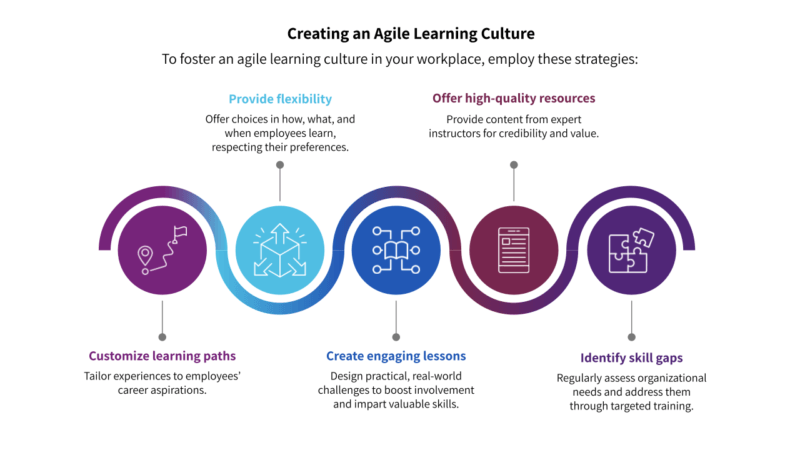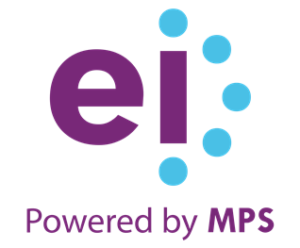Agility In Learning And Performance
In today’s competitive landscape, businesses face increasing challenges with a surge in new applications. According to the U.S. Census Bureau, the volume of new business applications surpassed 436,000 recently. [1] That comes on the heels of a 44% growth from pre-pandemic (2019) levels in 2022. [2] Why are these milestones critical? With over 50% of currently known skillsets for jobs expected to drastically transform by 2027, [3] the milestones highlight why organizations need highly skilled, experienced workforces to remain competitive. And for this, agility in learning is important. Workforces must swiftly identify, learn, and utilize the necessary skills to adapt to evolving requirements.
Learning agility is a crucial aspect of employee development. It indicates a commitment to embrace learning opportunities. However, relying solely on learning agility may not suffice to meet an organization’s performance objectives. To achieve true competitiveness, a workforce’s agility in both learning and performance is essential.
A significant 89% of learning professionals advocate a proactive approach to skill building. [3] This poses a challenge for L&D leaders to cultivate a culture that encourages and supports employees in their pursuit of learning and growth. Creating a learning environment promoting efficient skill acquisition and application becomes crucial. Such an environment empowers employees to keep pace with rapid changes in the business landscape, resulting in outstanding performance.
Agility In Learning Is Crucial For Employee Development
Learning agility comprises three crucial elements:
- Speed – Employees’ adeptness in identifying and acquiring necessary skills.
- Commitment – The level of engagement employees exhibit towards learning opportunities.
- Flexibility – The organization’s ability to adapt to changing needs.
An agile learning culture needs L&D leadership and workforce buy-in. Empowering employees to learn rapidly, such a culture fosters personal growth and helps organizations adapt to change.
Why Agility Will Help Organizations Move Toward The Future Of Learning
In the current environment, cultivating Learning and Development agility is essential for organizations to navigate the future of learning successfully. Embracing agility is crucial for the following reasons.
1. Rapidly Changing Skillsets
Technological advancements and market shifts lead to faster-evolving skills. Agility helps identify emerging skills and respond swiftly to keep the workforce competent.
2. Addressing Reskilling And Upskilling
Agility is the most effective approach to tackle reskilling and upskilling requirements. It enables targeted development, closing the skills gap, and staying ahead.
3. Boosting Retention And Engagement
In the competitive job market, continuous growth opportunities are crucial. An agile learning culture showcases commitment to employee development, enhancing job satisfaction, retention, and engagement.
4. Bridging The Internal Mobility Gap
Many employees feel constrained in their current career progression. An agile learning environment offers internal mobility pathways, empowering employees to explore new roles, acquire new skills, and advance their careers within the organization. This not only positively impacts employee satisfaction but also helps an organization retain talent and reduce external recruitment.
Embracing agile learning is vital to thrive in the future. Prioritizing agility positions organizations as leaders in an evolving learning landscape, ensuring long-term success.
Creating An Agile Learning Culture
To foster an agile learning culture in your workplace, employ these strategies:
- Customize learning paths – Tailor experiences to employees’ career aspirations.
- Provide flexibility – Offer choices in how, what, and when employees learn, respecting their preferences.
- Create engaging lessons – Design practical, real-world challenges to boost involvement and impart valuable skills.
- Offer high-quality resources – Provide content from expert instructors for credibility and value.
- Identify skills gaps – Regularly assess organizational needs and address them through targeted training.
Implementing these approaches empowers employees, encourages continuous growth, and helps adapt to a dynamic business landscape.
Adapting For Success
Fostering agility in learning performance enhances an organization’s ability to swiftly adapt to changing customer needs, market conditions, and business goals. Here’s how.
-
Adapting For Business Optimization
For business optimization, agility in learning entails data-driven decision making, a culture of continuous improvement, effective utilization of technology, and flexibility to change. A culture of continuous improvement empowers employees to innovate based on lessons learned, while learning technology and flexibility enable quick responses to market changes.
-
Embracing Change Management
Embracing change management involves clear communication, training, engagement, leading by example, and monitoring progress. Communicating the purpose and benefits of change aligns employees with organizational goals. Training equips them with skills and addresses concerns. Engaging employees sooner rather than later in the process makes them equal partners in the change initiative.
Agility And The Future Of Learning
Commitment To Continuous Learning
A genuine commitment to continuous learning is an important part of long-term success for any organization. Meeting this commitment requires incremental changes, just-in-time learning, and transparent discussions about challenges and improvement areas.
Agility is a nurtured process. It requires ongoing learning and active engagement. To embed agile learning successfully, organizations must dedicate themselves to continuous learning, identifying and addressing hurdles along the way.
Cultivating Agile Learning For Leadership Development
Agile leaders play a pivotal role in fostering a culture of continuous learning, leading by example with openness to innovation and change. By prioritizing learning and listening, they are able to navigate evolving circumstances effectively.
Leadership skills are rapidly evolving, and learning agility is crucial for real-time development. It enables leaders to exhibit new behaviors and drive positive team dynamics. Equipped with the right skills, leaders adapt to complexity and guide teams innovatively.
By embracing agile learning, organizations also cultivate agile leadership, enhancing adaptability, team performance, and successful navigation of dynamic business landscapes.
Parting Thoughts
In conclusion, learning agility empowers individuals to convert experiences into valuable learning opportunities, enabling them to tackle future challenges. It is a vital element for corporate success, particularly in times of change and uncertainty.
I hope this article provides insights to embrace agility in L&D. Organizations that foster a culture of learning and growth through learning agility will remain competitive and innovative, poised for continued success in an ever-evolving world.



